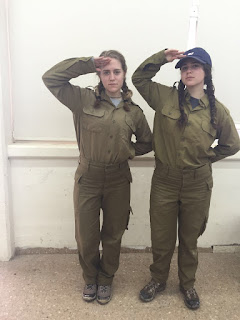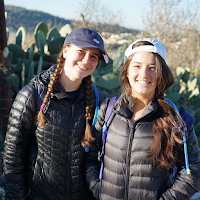The following is an essay Amber wrote for one of her NFTY-EIE classes following a trip to Poland
עמ
ישראל חי
We,
the Jewish people today, all stand as survivors. Not from the Holocaust necessarily, but from
our ancient, hate filled history. The
destruction of the first Temple, the destruction of the second Temple, the Bar
Kokhba revolt, the numerous pogroms, the exiles, and the continuous persecution
of the Jews to this day are all unforgotten attempts of vanquishing the Jewish
people. Time and time again we are
oppressed to the point of almost extinction.
Yet, we are still here.
A more recent example of these attempts at
ridding the world of the “Jewish problem” is the Holocaust. The Holocaust, an integral yet horrific part
of Jewish history, occurred in many places throughout Europe. Beginning in Germany, the Nazi regime soon
occupied and controlled nearby countries, such as Poland, which was a base for
many concentration and death camps. In
order to intimately learn about the Shoah, we went to Poland to see many of the
relevant places that related to the Holocaust.
Our trip encompassed many ghettos, former Jewish settlements,
concentration camps, and death camps.
Comprehending each destination was difficult considering we were
standing in a spot that used to be so active with Jewish life, but now there
are no Jews left. When traveling around
Poland, the spectrum of life and death witnessed made the entirety of the history and stories taking
place at each destination more meaningful.
During our Masa (trip) to Poland, we experienced
the amazing life that was created by the Jewish people. Tykocin, a vibrant Jewish shtetl since 1642,
perfectly defines what a lively community would entail. This community thrived on the sense of unity
it embodied. It was no stranger to
pogroms, which are anti-jewish riots, but through the adversity they still were
a prosperous society. On every Shabbat,
there would be an active market in order to prepare for the evening. One of the communities biggest attributes was
their willingness to help each other. When it came time for Shabbat, some
families realized that they did not have as prosperous of a week as
anticipated. This became problematic
when collecting materials needed to celebrate Shabbat. So, when this unfortunate circumstance came
about, other members of the community would lend them a chicken or some bread
for that week, and the next week the family would repay them with an item they
need.
Another part of
the community that depicts the life that was once there is the ancient
cemetery. This cemetery, one of the
oldest in Poland, portrays the life based upon the generations that are buried
there. The dilapidated cemetery is now
barely even recognizable as holy place that Jews were once laid to rest.
However, as I walked past each grave, I was still able to make out some of the
inscriptions engraved on them. Some read
“mom”, “grandfather”, and “rabbi”, proving that the society flourished for so
long to have to have multiple generations and classes of people
represented. While learning about the
Holocaust, it is often easy to forget about the life that once existed
before. These people had their own traditions,
lives, and feelings, and it is more important to commemorate what once existed
rather than just the way it ceased to exist.
The Nazi’s
eliminated the previously thriving life at Tycocin, was eliminated by the
Nazi’s in August 1941. The residents
were all gathered in the market square, which once represented life, but this
action foreshadowed the demise of their society. From the market square, they were taken to
the nearby woods in a town called Lopuchowo.
As we approached the woods in complete silence, the eeriness of the
whole situation began to hit me. Each
tree seemed to bear witness to the atrocities to which they were exposed. The trees are bare and no beauty remains with
them. I feel as though this is how the
Nazi’s wanted the Jews to feel, stripped
of all positive things, both physically and mentally exposed. But then, a sense crossed my mind of how
wrong it was that we were going to visit this site. It was not supposed to be this way. The Jewish people were no longer supposed to
exist. Here we are taking the same path that our ancestors traveled. The only
difference is that we were going to leave the woods alive.
On the days of
August 25th-26th, 2,000 Jews were murdered in three mass graves, completely
wiping out a society that was once brilliant with life. The people carrying out these acts of terror
were called the Einsatzkommando, and they were in charge of looking each person
in the face and shooting them. Men,
women and children were all killed in this incredibly personal, face-to-face
method. It is simple to think of the
number 2,000 as a whole; however, picturing each individual person, every
family, and the friendships that intertwines everyone, makes the horrific scene
begin to dawn upon you. Each life has a
story, and every life matters. The
concept of breaking down the numbers and looking at each number as an
individual being is the only way to retain the legacy of lives that were
terminated too soon.
Yiddish words are
personal to each family. Everyone has a
memory of a relative or some figure saying a yiddish word to them like “kepe” or
“puddum”. To me, these words represent a sense of comfort and familiarity when
spoken to me. A new word that was
introduced to me, and now the most important one in my quaint Yiddish
vocabulary is “iberleben”, meaning small acts of resistance. Iberleben is especially relatable to the Jews
of the Holocaust, because that is how they survived. They were the small acts that made the
ghettos, concentration camps, and other difficult situations in their lives a
little more bearable. For children,
ghetto life was especially confusing and difficult. All the time there were children left
orphaned because of the random murders and separations that took place. Janusz Korczack, who embraces the concept of
iberleben, set up an orphanage for children in the Warsaw ghetto. The ghetto walls formed their own version of
endless hell for the people living within them, but the orphanage created a
safe haven for the children of the ghetto.
Within this orphanage, Korczack set up the rules based on democratic
values. Each of the children had a say
in the system; this was very important, since at this time, they had no say in
anything happening in their lives.
Eventually, the ghetto was to be liquidated, and the children were the
first to go. They were to be marched to
the nearby Jewish cemetery and shot so they would fall into pits. Janusz Korczack was aware of the encroaching
fate that was about to end all of these young lives before they had even begun,
as well as his life. It is important to
note that Korczack had the option of not going to die right then, but to
prolong his life; however, he chose to die with his children. He had all of the children get dressed up in
their nicest clothing, and get ready to parade around the streets expressing
their youthful energy through song and dance.
His preserved these children’s last moments as happy and not filled with
terror. In the end, they all died
together, and this act of Iberleben showed that some things cannot be taken
away. Janusz Korczack gave these
children a caring community when they needed it the most. Even with the
acts of Iberleben, death still occurred.
In circumstances relating to Iberleben, the physical occurrence of death
is not the longstanding message, but the passive ways that people were able to
resist under the Nazi regime.
There are 613
recognized mitzvot. However, the most
important mitzvah is not even included in this group. Rabbi Fackenhiem once wrote the 614th
mitzvah: “Jews are forbidden to hand Hitler posthumous victories, they are
commanded to survive as Jews, lest the Jewish people perish”. My generation, the last that will be able to
talk directly to Holocaust survivors, has an added responsibility making sure
later generations are educated about the Holocaust. Continuing the Jewish tradition is very
important, because, as the quote states, if we relax our Jewish values and
morals too much, Hitler would be rewarded with a victory. It is important for every Jew to realize the
obligation they have to continuously carry out the successes of our
people. Personally, in order to follow
Rabbi Fackenhiem’s 614th mitzvah, I know that I will raise my children
Jewish. As well as raising my children
Jewish, I will instill upon them the importance of implementing the Jewish
traditions for the rest of their lives and the generations to follow. Along with the continuation of the Jewish
people, I will educate others about the Holocaust, ensuring that am yisrael,
the Jewish people, will continue forever.
Stepping into each
concentration camp, death camp, ghetto, and any other place where the Jewish
people were cruelly and unjustifiably persecuted increased my connection and
pride to my Jewish identity. The feeling
of being in the exact place where these incomprehensible tragedies occurred is
nothing like I have ever felt before. My
disbelief is completely logical considering I should not be able to understand
why or how these events could take place, simply because I am incapable of
having such hatred towards a group of people.
It is not normal to be able to hate a group of people and dehumanize them as much as the Nazis
did. However, these sadistic people
exist in all societies, and were able to create the the horror of the
Holocaust. It is our job as the Jewish
people to keep that from happening again.






